|
|

|
|
Author
|
Topic: Space Cover 455: Apollo 8 goes to the moon!
|
stevedd841
Member Posts: 299
From: Millersville, Maryland
Registered: Jul 2004
|
 posted 02-17-2018 07:50 AM
posted 02-17-2018 07:50 AM
   
Space Cover of the Week, Week 455 (February 18, 2018) 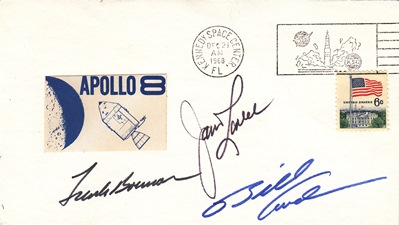 Space Cover #455: Apollo 8 goes to the Moon! It was NASA Associate Administrator Tom Paine's idea, and his plan was incredible. NASA had not even flown a manned Apollo space flight, yet, but Paine's plan went something like this. If the Apollo 7 flight went as planned, the next Apollo flight should go to the moon! His boss, George Low, at a conference in Vienna, Austria, yells at him over the telephone, "Are you out of your mind? It was 7:51 am, Eastern Standard Time on December 21, 1968, as Apollo 8 blasted off from Pad A at LC-39, Cape Canaveral, Florida. It was a picture perfect launch of NASA's first manned mission to the Moon. Borman yells over the thundering five rocket engines of the S-IC stage, "Liftoff; the clock is running!" It takes a long 13 seconds for the Saturn V rocket to clear the tower. The huge Saturn V pulls away from the tower and swiftly accelerates to mach 15 taking the Apollo 8 crew of Lunar Module Pilot Bill Anders, Command Module Pilot Jim Lovell, and Commander Frank Borman into their trajectory and Earth orbit. The first and second rocket stages fall away as the giant rocket speeds along its track and the Saturn rocket's third stage, the S-IVB rocket engine, powerfully ignites its 80 tons of liquid hydrogen propellant. The single engine fires for five minutes to achieve its final velocity of 17,500 miles per hour, propelling Apollo 8 into orbit 114 miles above the Earth. 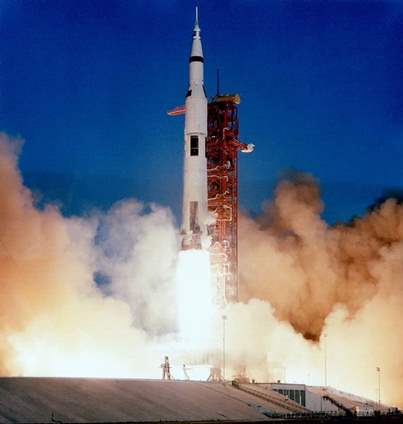 The official NASA cachet for the Apollo 8 flight, as for the Apollo 7 flight, is a NASA provided adhesive label, used on the cover pictured above and signed by the crew of commander, Frank Borman, command module pilot Jim Lovell, and lunar module pilot, Bill Anders, on the Apollo 8 launch date of December 21, 1968. This key launch date is also the first manned space flight of the huge Saturn V rocket and the crew going to the Moon. It is an important critical flight for future NASA lunar missions. Mission commander Frank Borman later writes, "The launch time — the predetermined time for lift-off based on the relative positions of the Earth and the moon and synchronized to the precise second... was 7:51 am, EST." Frank Borman later comments during post flight debriefing, "The sensation of speed increased as we picked up momentum, and so did the noise generated by 3,000 tons of metal pushing through the atmosphere. But when we passed the speed of sound, everything grew quiet, as if we were in a powerless glider. The only sound was a humming noise that came from the electronic equipment in the cockpit. The ride was incredibly smooth... I kept my hands on the controls, alert to any malfunction, but the automatic controls were working perfectly. Borman continues, "Houston was receiving telemetry data from its worldwide network of tracking stations even as we began testing every major system in the command and service modules. Every reading, every check, every button pushed, and every figure that appeared on a computer screen were all aimed at the ultimate decision: when to go for translunar injection (TLI) — the second and final firing of the third-stage rocket which would launch us toward the Moon. 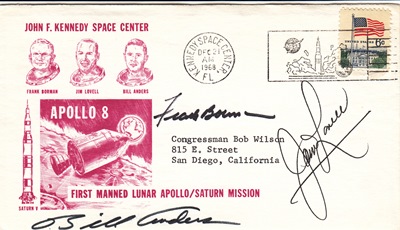 A Cover Craft cover is signed by the Apollo 8 crew and mailed to Congressman Bob Wilson of California on their launch date, December 21, 1968, from Kennedy Space Center, Florida. As cited in the cachet, this is the first manned Saturn Apollo lunar mission. The flight also is designated as AS-503. This crew signed cover mailed to Congressman Bob Wilson of California is a special cover, as he is a strong advocate of NASA's space program, and he supports significant space related industries in California. 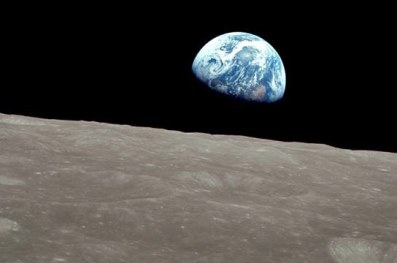 On the return journey around the Moon and now on a trajectory that would take it back to Earth, the crew is in awe of a final Earthrise as they start their epic journey home. Astronaut Bill Anders quickly grabs his camera and takes this iconic photo of the Earth rising over the Moon. His incredible photo caught on the way home becomes an epic photo for Apollo 8 and its successful first human journey to the Moon. — Steve, SU4379 |
micropooz
Member Posts: 1703
From: Washington, DC, USA
Registered: Apr 2003
|
 posted 02-17-2018 10:27 AM
posted 02-17-2018 10:27 AM
   
Great subject Steve! Below is one of my favorite Apollo 8 covers — a KSC official like Steve's only with the autographs of some of the Houston folks that made the mission possible: (upper left to lower right) Bill Tindall, Aaron Cohen, Max Faget, Chris Kraft, and Glynn Lunney. I got this signed at the Apollo 8 25th anniversary celebration at JSC in 1993. This was right before the time that Tindall's role (algorithms and software to navigate to the Moon) got widely recognized as the breakthrough that it was. When I asked him to sign the cover, he humbly asked "You want ME to sign this? Why?" When someone else approached him for an autograph, he (again) humbly said "You are the second person to ever ask me for an autograph. There goes the first!" (pointing at me). Fond memories...  |
Hart Sastrowardoyo
Member Posts: 3466
From: Toms River, NJ
Registered: Aug 2000
|
 posted 02-17-2018 12:00 PM
posted 02-17-2018 12:00 PM
   
If I'm reading this right, the Cover Craft was signed by the crew and then dropped into the mailstream? If so, I'm amazed it got through to the Congressman. Or was it addressed, signed and postmarked but put inside another envelope before being mailed? |
stevedd841
Member Posts: 299
From: Millersville, Maryland
Registered: Jul 2004
|
 posted 02-17-2018 12:46 PM
posted 02-17-2018 12:46 PM
   
Dennis, many thanks for telling the rest of the story from Houston especially the critical role that Bill Tindall played in putting together the algorithm and software for navigation by the crew of Borman, Lovell, and Anders, to the moon. This is one of my favorite stories about how we got to the moon, and in my estimation, for trying this without a manned test flight with a Saturn V rocket with a crew going to the moon for the first time, could have had any other results than the successful one they achieved. The test indeed was incredible and a credit to the Apollo 8 crew. |
stevedd841
Member Posts: 299
From: Millersville, Maryland
Registered: Jul 2004
|
 posted 02-17-2018 12:57 PM
posted 02-17-2018 12:57 PM
   
quote:
Originally posted by Hart Sastrowardoyo:
If I'm reading this right, the Cover Craft was signed by the crew and then dropped into the mailstream?
I took the cover out of its album to check and am surprised to report that the envelope indeed had been sent through the mail. It appears to have been opened after being received by Congressman Wilson. It is an added surprise for the Apollo 8 mission that I was not aware of. Thank you for adding to the story of the Apollo 8 mission. |
Ken Havekotte
Member Posts: 3668
From: Merritt Island, Florida, Brevard
Registered: Mar 2001
|
 posted 02-17-2018 02:32 PM
posted 02-17-2018 02:32 PM
   
One of the best vintage crew signed Apollo 8 KSC-ONC covers that I have seen, Steve, with a bold signature of Anders from that time period. Very nice indeed!Your opening comments, though, had me confused about Tom Paine's role in Apollo 8's early mission proposal of going to the moon without a LM. Actually, Paine was a senior NASA administrator (as the agency's No. 2 man as "Deputy Administrator" throughout most of 1968) based in Washington, D.C. and would have authority over Low. On the other hand, Low was based at NASA's MSC/Houston and held a top management role position there to lead the Apollo spacecraft program responsibilities. In this capacity, Low would have a much better assessment of how Apollo's timetable on a daily basis was progressing and would report those findings to his superiors at both MSC and NASA HQS.
I have always believed it was George Low, at the time in 1968 was Manager of the Apollo Spacecraft Program Office at MSC, first proposed on Aug. 7, 1968, a solution to keep Apollo 8 on track since the first manned lunar module (LM-3) had been behind schedule and would not be ready to fly for the rest of the year. Never before have I heard that Paine had the original idea. It was at that same meeting that Low asked Chris Kraft, MSC's Director of Flight Operations, to consider maybe sending CSM-103 to the moon as a solo flight (without a LM) to accelerate Apollo's timetable. MSC Director Bob Gilruth and flight crew operations boss Deke Slayton were also involved in that initial meeting to possibly fly Borman's crew to the moon in Dec. 1968. At the same time, though, Low wasn't in Vienna. It was NASA's George Mueller, Associate Administrator for Manned Spaceflight, along with NASA Administrator James Webb, that were attending a discussion panel on the Peaceful Uses of Outer Space in Austria, hosted by the United Nations. While Tom Paine was NASA's Deputy Administrator in Aug. 1968, other meetings with higher-up space agency officials (Paine included) took place that entire week to discuss Low's initial idea of flying the first manned Apollo/Saturn V mission around the moon without a LM. Concerning Apollo 8 having no manned test flight of the big lunar rocket before going to the moon, while certainly true, NASA did though conduct two successful unmanned Saturn V flight tests before Apollos 7 & 8, even though the second unmanned Saturn V flight was considered a "partially successful" mission. The original flight plan was to launch the first Saturn V mission into Earth orbit with LM-3 and a manned crew, however, another possible unmanned Saturn V launch vehicle flight after AS-502 was deemed not necessary before a manned crew was to fly "the stack." Of course, though, during 1966-67, there had been other proposed manned Apollo spacecraft mission considerations, with using the Saturn 1B launch vehicle. In the long run, though, after the AS-204 spacecraft fire tragedy, only one 1B was used to launch the first and only pre-moon voyage
Apollo crew in Oct. 1968. Next up would be a manned crew for the mighty Saturn V moon rocket that would fly man's first lunar orbital mission in just a few short
8 weeks after Apollo 7! But since the flights had been switched around, Apollo 8 before 9, why not launch Apollo 8 with a manned crew since there was a "flight ready" CSM ready to fly? It would indeed be a bold and perhaps risky proposal, but there was a major concern and real fear that the Russians in 1968 might beat us to the moon first. Regarding Bill Tindall, I do recall writing him at MSC/Houston as a young teen during the early manned Apollo Program years and requesting his signature on a space cover or two along with a signed photo of him. He did respond, and if I recall correctly, included a nice letter as well. I'll check on them later.
|
stevedd841
Member Posts: 299
From: Millersville, Maryland
Registered: Jul 2004
|
 posted 02-17-2018 07:21 PM
posted 02-17-2018 07:21 PM
   
Ken, I really appreciate your comments and view of the Apollo 8 manned spaceflight from a historical perspective. It all seems somewhat unreal now, astronauts would get into a Saturn V rocket, and take off to the Moon? It almost doesn't seem possible, does it? |
Ken Havekotte
Member Posts: 3668
From: Merritt Island, Florida, Brevard
Registered: Mar 2001
|
 posted 02-18-2018 09:24 PM
posted 02-18-2018 09:24 PM
   
Hard to believe, Steve, that half a century had gone by since Apollo 8 had journeyed to the moon!
I can still well remember viewing the launch "live" from the Florida Space Coast on that December day in 1968. It was my second "live" manned launch viewing, but my first Saturn V moon rocket witness. Even to this day, the rumble and vibration of that first and mighty manned "monster rocket" will forever be etched on my mind.
Of all the historical manned spaceflight voyages, Steve, I would have to say Apollo 8 is by far one of my favorites with so much riding on it.For this young teenage boy, it left an impression on me that I would never forget, and little did I know at the time, it would help shape my own future goals of an unusual lifetime "space" career. Perhaps now — 50 years later — would be a good time to highlight some of the mission's incredible accomplishments: - First men to journey beyond the Earth and orbit the moon
- First manned Saturn V moon rocket launch and flight
- First manned use of Launch Complex 39 of Spaceport USA
- First pictures of Earth and moon from deep space taken by astronauts
- New world speed record of 24,200 mph
- First live TV coverage of the lunar surface
- Crew was named Time magazine's 1968 Men of the Year (are there any crew signed issues out there)?
|
Ken Havekotte
Member Posts: 3668
From: Merritt Island, Florida, Brevard
Registered: Mar 2001
|
 posted 02-19-2018 12:50 PM
posted 02-19-2018 12:50 PM
   
Here are some of my own crew signed Apollo 8 covers and photos with two of the entries having been signed in crew quarters before their historic lunar voyage in Dec. 1968.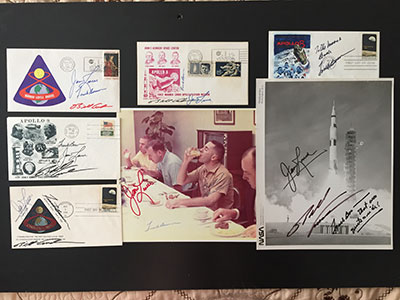 |
Robert Pearlman
Editor Posts: 50995
From: Houston, TX
Registered: Nov 1999
|
 posted 02-19-2018 01:00 PM
posted 02-19-2018 01:00 PM
   
quote:
Originally posted by Ken Havekotte:
I have always believed it was George Low...
Indeed, according to NASA it was. From the Aug. 9, 1968 entry in "The Apollo Spacecraft: A Chronology" (SP-4009): ASPO Manager George M. Low initiated a series of actions that led to the eventual decision that AS-503 (Apollo 8) should be a lunar orbital mission. Events and the situation during June and July had indicated to Low that the only way for the "in this decade" goal to be attained was to launch the Saturn 503/CSM 103 LM-3 mission in 1968. During June and July the projected launch slipped from November to December, with no assurance of a December launch. Later, Low recalled "the possibility of a circumlunar or lunar orbit mission during 1968, using AS-503 and CSM 103 first occurred to me as a contingency mission."...August 9 was probably one of the busiest days in George Low's life; the activities of that and the following days enabled the United States to meet the "in this decade" goal. At 8 :45 a.m. he met with MSC Director Robert R. Gilruth and told him he had been considering a lunar orbit mission. Gilruth was highly enthusiastic. At 9:00 a.m. Low met with Kraft and was informed that the mission was technically feasible from ground control and spacecraft computer standpoint. (A decision had been made several months earlier to put a Colossus onboard computer program on the 103 spacecraft.) At 9:30 a.m. Low met with Gilruth, Kraft, and Director of Flight Crew Operations Donald K. Slayton, and they unanimously decided to seek support from MSFC Director Wernher von Braun and Apollo Program Director Samuel C. Phillips. Gilruth called von Braun and, after briefly outlining the plan, asked if they could meet in Huntsville that afternoon. Low called Phillips, who was at KSC, and asked whether he and KSC Director Kurt Debus could participate and a meeting was set up for 2:30. Present at the 2:30 p.m. meeting at MSFC were von Braun, Eberhard Rees, Lee James, and Ludie Richard, all of MSFC: Phillips and George Hage, both of OMSF; Debus and Rocco Petrone, MSFC; and Gilruth, Low, Kraft, and Slayton of MSC. Low outlined the hardware situation and told the group it was technically feasible to fly the lunar orbit mission in December 1968, with the qualification that Apollo 7 would have to be a very successful mission. If not successful, Apollo 8 would be another earth-orbital mission. It then fell to Phillips to inform Associate Administrator for Manned Space Flight George Mueller and NASA Administrator James Webb, who were in Vienna for a United Nations meeting. It is not until Aug. 14, does Paine get involved, when he congratulates Low and company for devising the idea and says "he personally felt it was the right thing to do." So credit for the idea of sending Apollo 8 to the moon falls to Low, and, per the same source, it was Webb who was initially "shocked and fairly negative" about the plan. | |
Contact Us | The Source for Space History & Artifacts
Copyright 2023 collectSPACE.com All rights reserved.

Ultimate Bulletin Board 5.47a
|
|

|
 advertisement advertisement

|

















